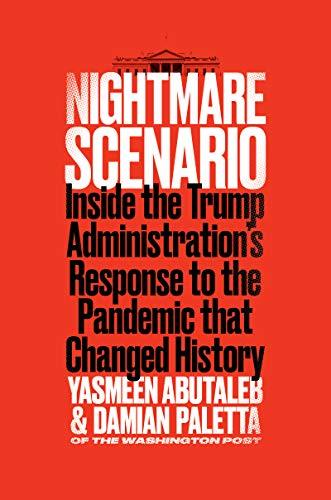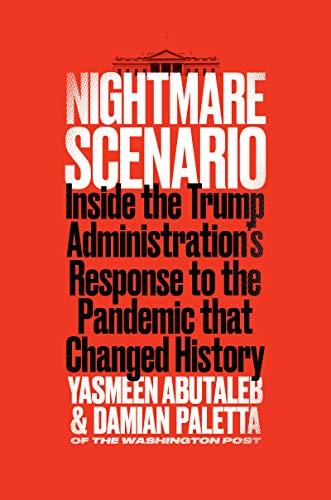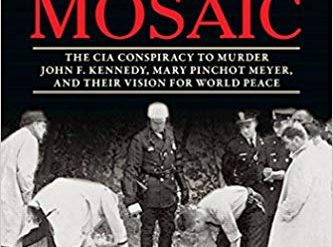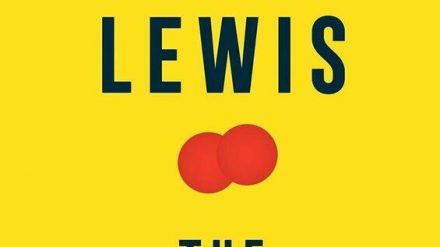
The phrase “nightmare scenario” in the title of this rushed exposé of the Trump Administration’s response to COVID-19 has a double meaning. It refers, of course, to the pandemic itself. Not the worst case scenario like the 1918 influenza epidemic, which killed an estimated 50 million people, but bad enough. After all, at this writing, 600,000 Americans (and a worldwide total of at least 4,000,000) have died of coronavirus disease. Our nation’s death toll is greater than that from all the wars fought by the United States throughout the twentieth century (and it’s not over yet).
But the title also reflects the insanity of the scene that unfolded within the White House. Throughout 2020, Donald Trump and his closest advisers racked up an alarming record of tragically misguided decisions. The story could well serve as a case study in public health administration to illustrate the worst possible way for the US to deal with pandemic disease.
A government at war with itself
In fairness, the White House got a few things right. Operation Warp Speed, for example, the intensive drive to develop many vaccines that was akin to the Manhattan Project in its scope and cost. That was, in fact, a spectacular win. There were a few others of much lesser importance. But most of what the Administration did right didn’t come from the White House staff, much less from Trump himself. What was accomplished was primarily the work of lower-level officials in the Centers for Disease Control, the Department of Health and Human Services, and other agencies—almost always in the face of intense and often ferocious opposition from the President and his staff. To the extent that the government’s response to COVID was effective, it was because of these unsung officials.
Nightmare Scenario: Inside the Trump Administration’s Response to the Pandemic that Changed History by Yasmeen Abutaleb and Damian Paletta (2021) 425 pages ★★★★☆

No superheroes in the response to COVID
There are no superheroes in Nightmare Scenario. But some individuals did display uncommon courage.
Anthony Fauci
Of the doctors who played central roles in the response to COVID Anthony Fauci stands out. He was often alone in daring to contradict the President, and he gained newfound national prominence as a result. But even he made mistakes—rather big ones at that—especially early in the year. (Fauci has been Director of the National Institute of Allergy and Infectious Diseases since 1984. He now also serves as Chief Medical Adviser to President Joe Biden.)
Stephen Hahn
Other now-familiar figures were more erratic, usually because they felt forced to succumb to pressure from the White House. Stephen Hahn, Director of the FDA from 2019 to 2021, too often acceded to unreasonable and sometimes dangerous demands from Trump’s staff. Only later in the year, as field testing of the Pfizer and Moderna vaccines neared its end, did he show strong backbone and insist on following established protocol to ensure the vaccines were both safe and effective.
Deborah Birx
Deborah Birx, who served as White House Coronavirus Response Coordinator from 2020 to 2021, frequently expressed support for even the most outrageous statements from President Trump or his advisers in the vain hope they would continue to listen to her recommendations.
The naysayers
By contrast with these doctors, all of whom felt they were doing their best under difficult circumstances, nearly every key member of the White House staff comes off very poorly in Nightmare Scenario. “The response had turned into a toxic environment in which no matter where you turned, someone was ready to rip your head off.” The worst offenders are:
- Mark Meadows, who was the White House Chief of Staff from March 31, 2020, to January 20, 2021
- Secretary of Health and Human Services Alex Azar, who served from January 2018 to January 2020. “Azar’s high-handedness and perceived micromanagement were proving to be a constant theme in the dysfunctional response” to COVID.
- Peter Navarro, for whom President Trump created the bogus National Trade Council. (Navarro was the only member and a staff of one.) “Trump didn’t like nuance; he liked fire-breathers.. And Navarro was his dragon.” The man didn’t seem able to dial down his aggressive and often abusive treatment of public health officials.
- Dr. Scott Atlas, a zealous Right-Wing activist trained as a radiologist who fed a constant stream of dangerous ideas to Donald Trump. He insisted that the only effective response to COVID was to allow everyone to get infected so as to achieve herd immunity nationwide. That millions would die in the process was of no interest to him.
- President Trump’s son-in-law, Jared Kushner, who arrogated to himself authority over just about everyone other than the president. He wreaked havoc over regulations, directing subordinates to give priority to his personal friends, and generating torrents of good publicity but very few positive results. However, he was instrumental in shepherding Operation Warp Speed through the bureaucracy.
- And Vice President Mike Pence‘s two principal advisers, Communications Director Katie Miller and Chief of Staff Marc Short. “The abrasive, dominating force that Miller and Short tried to exert on others in the White House was intimidating by design.” By contrast, the Vice President himself comes across as always willing to listen to the doctors and as unfailingly polite, but in his consistent refusal to disagree publicly with the President he seems worthy of a profile in cowardice. In a word, he pandered to the President. “If Birx said that things were worsening in forty-six states but improving in four states, Pence would highlight the four states with encouraging news.”
All told, there were few bright spots in the Trump Administration’s response to COVID. “It was a circular firing squad.”
Why was the White House response so counterproductive?
When all is said and done, a big question lingers. Why was the Trump Administration’s response to COVID so dysfunctional? As best I can tell from reading Nightmare Scenario and other books about the pandemic, there were four principal reasons.
Ideological handcuffs
Key members of Trump’s staff were zealous libertarians who revolted against the measures public health doctors insisted were most effective in preventing exposure to the disease. Wearing masks. Social distancing. Closing bars, restaurants, barbershops, and public venues. And canceling large public gatherings of any kind. They likened these essential, life-saving measures to tyranny.
Incompetence
It’s difficult to conclude from reading Abutaleb and Paletta’s account without understanding that some key figures in the Administration were incompetent, even though they never use the term themselves. For example, Trump’s Secretary of Health and Human Services, Alex Azar, comes across as incapable of understanding the functions of the several health agencies under his direction. And in his zeal to please his boss at every turn, he repeatedly undermined the physicians who served under him. The behavior of Mark Meadows was similarly problematic. Again and again, the authors describe his screaming matches with public health officials in his continuing effort to bully them to toe the President’s line.
Institutional weakness
Reading between the lines it becomes clear that “systemic issues . . . plagued the response from the outset” starting with “chronic underinvestment in public health.” But bureaucratic issues weighed in as well. There are many agencies involved in public health, with overlapping and sometimes conflicting responsibilities. In telling the tale of the government’s response to COVID, Abutaleb and Paletta cite a welter of Federal agencies as well as the innumerable public health departments at the state and local level throughout the country. They found themselves competing with one another for resources and attention in their own disjointed response to COVID. The problem might have been partially solved with strong leadership from the Oval Office. But no leader, however effective, could eliminate the overlap and contradictions in the bureaucracy. Reform is urgently needed before the next pandemic strikes.
Donald Trump himself
The buck stops in the Oval Office, and Donald Trump himself is responsible for his Administration’s tragic conduct in 2020. After all, even though subordinates on his staff more directly caused some of the biggest problems, he hired and defended them. And his own conduct was reprehensible. As the authors notes, “Instead of uniting the country to fight a common enemy—a microscopic assassin threatening to destroy the country . . . he used it as a wedge to further divide an already deeply fractured nation.”
- By denying the seriousness of the disease for month after month. “He didn’t want to deal with the coronavirus and believed he could make it go away by willing it to do so.”
- Declaring, in fact, on innumerable occasions that the problem was already in the rear-view mirror, when in fact COVID was raging out of control at the time.
- Publicly touting ineffective and even dangerous drugs to combat the virus. Even implying that swallowing bleach would kill it.
- Consistently trying to slow down the use of testing. “‘If you don’t test, you don’t have any cases. If we stop testing right now, we’d have very few cases, if any.'”
- Organizing and promoting superspreader events, where hundreds or thousands gathered without even the most minimal public health precautions.
- Refusing to listen to the doctors most responsible for managing the response to the pandemic.
- And, most astonishing of all, after his own near-death bout of the disease, continuing to insist that COVID isn’t a threat.
In the popular nationally syndicated cartoon strip, Doonesbury, Garry Trudeau now depicts Donald Trump with blood on his hands. It seems apt.
About the authors

According to her bio for the Washington Post, Yasmeen Abutaleb joined the paper “in 2019 as a national reporter covering health policy, with a focus on the Department of Health and Human Services, health policy on Capitol Hill and health care in politics. . . In 2016, Yasmeen was a lead reporter on a five-part series that examined the rising threat of antibiotic-resistant infections and the inability of the government and health-care industry to address the problem.”

Damian Paletta has worked as a journalist for the Washington Post since 2002. He is currently its economics editor. For him, as well as for Abutaleb, Nightmare Scenario is his first book.
For more reading
This is one of The best books of 2021.
I’ve also reviewed The Premonition: A Pandemic Story by Michael Lewis (What went wrong in the COVID pandemic?). And you can find a list of books on related topics at Books about epidemic disease and the COVID-19 pandemic.
You may also be interested in:
- The Great Influenza: The Story of the Deadliest Pandemic in History by John M. Barry (A brilliant account of the 1918 flu epidemic)
- The Code Breaker: Jennifer Doudna, Gene Editing, and the Future of the Human Race by Walter Isaacson (CRISPR technology may change the world as we know it)
- Science explained in 10 excellent popular books (plus dozens of others)
- The top 5 books about Donald Trump and his impact on American democracy
I’ve included all the best books I’ve read about the pandemic here: Books about COVID-19 and other pandemics.
And you can always find my most popular reviews, and the most recent ones, plus a guide to this whole site, on the Home Page.


























